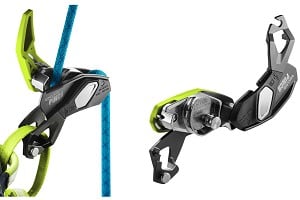
Assisted-braking belay devices are popular for indoor and outdoor sport climbing with a single rope, adding extra braking in the event of a fall and for lowering off and top roping. In this comparative review seven of the currently available models go head to head.
The Petzl GRIGRI first appeared in 1991 and since then has pretty much been the market leader in assisted-braking belay devices. During that time it has undergone two design upgrades, in 2011 and 2016. In more recent years a number of other devices have come onto the market which use a variety of different systems to essentially achieve the same aim - to help you safely belay your partner in the event of a fall, or just in general use indoors and out when climbing and lowering off. We had a look at some of these in a video review back in 2011.
What is an assisted-braking belay device?
With conventional belay devices, the degree of braking applied during operation is almost entirely due to what position the braking rope is held in, and how hard it is gripped in the belayer's hand. An assisted-braking device is one that offers an increase in the braking action when the device comes under the sudden load of a fall, and may also have a lock to aid smooth lowering off.
It is important to note that assisted-braking belay devices are not 'autolocking' since they require careful use and will not necessarily 'automatically lock' if used incorrectly.
The two basic mechanisms used by the devices on the market are the camming system (GRIGRI and Matik) and a sliding system which relies on the belay krab and the device working together (Click-Up, Jul2, Smart and Ergo). The camming system tends to result in slightly larger devices but ones which are more solid feeling. Devices using the sliding system can be extremely small and lightweight and they are generally cheaper, but tend to be less versatile.
For this article we have chosen seven current devices. We were hoping to include the Revo from Wild Country too - but this is not yet available, so we will aim to add this at a later date. The devices were tested over a period of months at Awesome Walls in Sheffield and outdoors at various crags including in Finale Oltra in Italy.
While testing we focussed primarily on use for indoor and outdoor sport climbing, rope feed to leader, lowering off and fall catching. We have not actively considered other activities that these devices can be used for, such as abseiling and big wall climbing - although we have mentioned some other uses in some places. The main aim is to introduce these devices to people who haven't used one, or who are unfamiliar with the various options.
If you are regularly working routes, then you may prefer one of the more substantial devices in this test. Whilst all seven do lock off solidly, it generally feels more reassuring to have a bigger device. Of course you should always keep hold of the control end of the rope, even when the leader is resting and the device locked off - despite what you may see others doing.
It should be stressed that belay devices are items that you need to get used to, that different users may have a personal preference, and that once accustomed to a particular model, changing to a new one can be disconcerting. Basically, if you are happy with the device you have at present then we would say stick with it. But if you are unhappy, or haven't yet made up your mind, then hopefully this group test will help.
Overall summary
|
Make and model |
Ratings | |
|
Petzl GRIGRI + Price: £85 Weight: 200g Rope diameter range: 8.9mm to 10.5mm |
General handling
Rope feed
Lowering
Value
Overall
|
|
|
Petzl GRIGRI 2 Price: £60 Weight: 170g Rope diameter range: 9.4mm to 10.3mm |
General handling
Rope feed
Lowering
Value
Overall
|
|
|
Mammut Smart Price: £26 Weight: 82g Rope diameter range: 8.7mm to 10.5mm |
General handling
Rope feed
Lowering
Value
Overall
|
|
|
Edelrid Jul2 Price: £25 (£45 with belay krab) Weight: 87g Rope diameter range: 8.9mm to 11.0mm |
General handling
Rope feed
Lowering
Value
Overall
|
|
|
C.A.M.P. Matik Price: £100 Weight: 276g Rope diameter range: 8.6mm to 10.2mm |
General handling
Rope feed
Lowering
Value
Overall
|
|
|
Climbing Technology Click-up Price: £65 Weight: 115g Rope diameter range: 8.6mm to 10.5mm |
General handling
Rope feed
Lowering
Value
Overall
|
|
|
Salewa Ergo Price: £70 Weight: 80g Rope diameter range: 8.6mm to 11mm |
General handling
Rope feed
Lowering
Value
Overall
|
Petzl GRIGRI + £85

Firstly, the GRIGRI + isn't designed to be a replacement for the GRIGRI 2 - they are intended to sit alongside each other in the range. That said, it's worth comparing the GRIGRI + to the GRIGRI 2 as the latter will be familiar to many reading this review. At 200g the GRIGRI + is 30g heavier than the GRIGRI 2. This is down to a subtle increase in size, which we feel has resulted in an improvement in its handling. It sits better in the hand, has a larger and more robust handle and a stainless steel wear plate to increase durability.
A significant addition to the GRIGRI + is a switch to toggle between two modes - lead mode or top-rope mode. When in lead mode the rope flows freely through the device; when in top-rope mode the camming mechanism becomes grabbier, meaning that the rope grabs a lot quicker. Although this feature was designed with beginners in mind, it also adds some functionality for more experienced climbers.
Setup is straightforward and the same as previous GRIGRI models. The device has illustrations printed on it to guide you.
The rope feed with the GRIGRI series has always been something that some climbers take to very quickly and others don't like finding it too grabby when trying to pay out. An extra technique, approved by Petzl, has been developed to enable a smoother rope feed when trying to pay out quickly which involves using your thumb to hold the cam down while maintaining your grip on the braking end of the rope. It is initially quite an awkward technique to use but those who do master it tend to swear by the GRIGRI as their chosen device.
Rope feed on the GRIGRI + varies according to which of the two modes you have it in: lead mode or top-rope mode. As expected, in top-rope mode it is virtually impossible to feed the rope out, but relatively easy to take in. In lead mode the rope feeds through much more slickly, in fact it is smoother than the GRIGRI 2 in our opinion.
The GRIGRI + claims to work at optimum across a wider range of rope diameters than the GRIGRI 2, ranging from 8.9 - 10.5mm (compared to 9.4 - 10.3mm). This was something of a problem with the GRIGRI 2 since that claimed to work with ropes of 10mm and above but really didn't function well with fatter ropes. The GRIGRI + is an improvement in this respect. Markings on the device itself suggest hat you can use ropes up to 11mm, though that is outside Petzl's 'optimum' range. In use there is definitely a compromise in handling at the thicker end, especially with older climbing wall ropes, and most climbers will find it too grabby with fat old ropes.
The GRIGRI + features a much more controlled release than the GRIGRI 2, courtesy of an improved camming mechanism. The result is a move away from the binary on/off and towards a more subtle/adjustable level of control irrespective of the diameter of the rope. If this weren't enough to improve the safety and functionality of the device then the panic mode will be of further interest for novice users (or people being belayed by novices). The panic mode is engaged when the handle is pulled too far back and leads to the device locking immediately. It can be released in one of two ways: firstly, by resetting the handle back to its resting position, or secondly, by overriding it - which involves pushing it down further still. The override function has been criticised for negating the purpose of having the failsafe in the first place but, in our opinion, once the panic mode has set in it would be highly unlikley for someone to continue overriding, as the force required to do so would be substantial (not to mention quite counterintuitive). The main benefit of the override is that, for routes where there is a lot of drag, it remains possible to pay out slack without panic mode engaging; something that other cammed devices like the Matik really fall short in.
Summary: The added functionality of the GRIGRI + makes it a particularly attractive option not only for novices, but also more experienced climbers, people that frequently climb with novices and those who have been using earlier GRIGRI models. The increased control on the release is an improvement and the anti-panic function and override is a nice touch; however, we suspect that the increase in price will put many people off. That said, with the stainless steel wear plate featuring in the updated design this is a device that will last you a long, long time. Those who have happily used any version of the GRIGRI in the past may find this item worthy of their own personal 'best in test' tag.
Petzl GRIGRI 2 £60
Since this is still very much a device of choice for many climbers, it would be remiss of us not to include a brief reappraisal of the GRIGRI 2 especially when you consider the price difference to the GRIGRI +. We did cover it in our previous Assisted-braking Belay Device group test in 2011.
The main difference between the two devices is the addition in the + model of extra safety features like auto-lock when lowering too fast, and the switch to change from lead to top roping mode. Without these extra safety features the GRIGRI 2 is better suited as a device for more experienced climbers since it does require a bit of getting used to in order to master properly.
The GRIGRI 2 is rated for optimum performance with ropes from 8.9mm to 10.3mm. We found that the rope feed with skinny ropes (<10mm) was good and gave few problems. It also performed significantly better than the old GRIGRI when holding falls on these thin ropes and overall the action was excellent and intuitive. With a new 10mm rope it became a little more 'grabby' when feeding but was still perfectly useable. For an old furry 10mm rope we found the grabbiness of the device started to become a problem and it was quite a struggle to feed it through the device with any ease. We tried a new 11mm rope and weren't able to get this to work properly at all despite the device stating that it does function with ropes of up to this diameter.
The lowering action is smooth and easy to get used to but does take some practice to perfect. The addition of the auto-locking feature in the GRIGRI + is testament to the problem of inexperienced users panicking and pulling even harder on the lever of the GRIGRI and GRIGRI 2, resulting in some rapid descents.
As a general device to have on your rack the GRIGRI 2 is very versatile and you will see it being used by many for all sorts of extra purposes like route setting at climbing walls, and taking photographs from an abseil rope. You will also see many still using the original GRIGRI for these purposes since it is even more robust.
Summary - Thousands of climbers around the world use this device and would not change even if you paid them. That says how reliable it is. Having said that, for new users it doesn't handle as well as the Click-Up and doesn't have the safety features of the GRIGRI +. For those with more experience, it remains good value and a versatile addition to your gear.
Mammut Smart £26
The Mammut Smart has no moving parts and is a relatively simple device to use, being similar to a conventional belay device in its action. The basic construction relies on the rope trapping itself against the belay carabiner and a metal bar. The angle of the device dictates how grabby this is so that you can alter the angle to lower the climber when required. It has an extended lever section with a plastic insert that gives us some concern over durability since this is the section the rope runs over every time your lower off.
Threading the device is pretty straightforward although there is a right way and a wrong way - but this is illustrated clearly on the device. Once climbing, the rope feed is relatively smooth although you do need to hold the device with your other hand otherwise it will lock. This is similar to the Edelrid Jul 2 and the Salewa Ergo and may not be familiar to those who have only used a traditional belay device which you don't touch with your hands during general operation.
It behaves well when holding a fall and it proves reasonably easy to lower people, although the Smart offers less control than, for instance, the Click-Up. There have been a few occasions when testing where the lowering proved a little jerky, but nothing too worrying. There is no auto-lock on the device if you lower the climber too quickly as with some of the more sophisticated cammed devices like the GRIGRI + and the Matik, but just releasing your grip on the device (not the rope) will initiate a lock as the rope pulls the angle more horizontal.
The Mammut Smart is rated for 8.7mm to 10.5mm ropes. In our testing we found that there was some slippage through the device when holding falls on a 9mm single rope and it didn't lock fully; however the feed wasn't compromised at all with thicker ropes. It doesn't come with a belay carabiner, which is odd considering that the carabiner is integral to the locking system. We tried it with a couple of carabiners including some thinner ones. It still functioned but the slippage was slightly increased with the thinner belay krabs and it is not recommended that it be used with anything other than a solid belay carabiner.
Summary - A very simple device with a good user-action similar to conventional belay devices. It suffered from slippage on thinner ropes, has no safety auto-lock when lowering and has a plastic section taking some of the everyday wear and tear. A very attractive price but it doesn't come with its own belay carabiner, though a proper chunky belay carabiner is essential for use.
Edelrid Jul 2 £25

When it comes to threading the device there is a correct/incorrect way to do it. The correct method is indicated by two diagrams on the side of the device. Due to the smaller size of the device this isn't overly obvious upon first acquaintance, so if you are a novice climber, or climbing with novices, it would be worth double checking this before setting out on the sharp end.
In terms of durability the stainless steel construction is likely to mean this devices lasts for a very long time and this is a distinct improvement on the original Jul. It is available with and without a belay carabiner with a difference of £20. The carabiner supplied is steel and we would advise that this is the option to go for. The device does tend to mark up the belay carabiner with scratches which isn't ideal, so if you don't get the carabiner set then make sure you use it with a proper solid steel belay carabiner and not any old aluminium thing. In addition to this, much like the Click-Up, the carabiner and device can get very warm when lowering.
There is a slight knack to paying out slack, which involves keeping your thumb within the retainer. That said, this 'knack' is actually quite intuitive and the thumb catch/loop quite large, so it occurs quite naturally and is quickly learned. This action is similar to the Mammut Smart and Salewa Ergo but, of these three, the Jul 2 is the easiest to feed with.
The device is suitable for ropes between 8.9 - 11mm, a highly impressive range and one that lives up to its claims, paying out 11mm ropes surprisingly easily. Lowering however is definitely at the speedier end of the spectrum, being a lot faster than you'd expect, and it takes a little time to get your head around how best to do it. There is no auto-lock.
It does give a reasonably soft catch although, as with most of such devices, it is a bit on/off and best used in combination with proper dynamic belaying.
Summary: A good, simple and hard wearing device at an excellent price. Very light and simple and the best of the devices on test that require a hand on to feed the rope out. The lowering action can be difficult to master, resulting in some faster descents than many might expect - which could be quite alarming for novice users. The issue of the hard stainless steel leaving burring marks on your belay carabiner is a negative but it would take a long time to cause significant non-cosmetic wear if you use either the steel carabiner available in a set, or something similar.
UKC dedicated review - November 2016
C.A.M.P. Matik £100
The C.A.M.P. Matik works on the same principle as the GRIGRI in its various different guises. It is a good looking and solid feeling device but it does come with a relatively high price tag of £100 for 2017. Is it worth the extra money?
Loading the device requires you to thread it in the correct direction which is clearly illustrated on the side. Then closing it up and adding the carabiner securely locks the device and any carabiner will do since it isn't part of the locking system.
In use rope feed is smooth - in fact noticeably smoother than with any version of the GRIGRI. It does grab if you pull it too quickly and isn't great on ropes fatter than 10mm (it is rated for ropes 8.6mm to 10.2mm although only up to 9.6mm as optimum) however we've found it's possible with practice to get pretty good at a smooth feed technique. Experienced GRIGRI users often use a thumb technique to help hold the cam in the device down when feeding the rope really quickly. 'Thumbing' with the Matik isn't possible owing to the shape of the device and you can only use it with one hand above and one hand below which means that it is likely to be too grabby when your leader goes for a sudden quick clip.
In lowering the side lever needs to be used to release the rope, and lowering is relatively smooth. We did however encounter quite a serious problem with the auto-lock system which is very sensitive. If there is a lot of drag in the rope, or your climber is extremely light, then it is relatively easy to trigger the auto-lock. You can release it again but it does create a jerky lowering experience. It has also caused us problems when the climber touches the ground since the release of weight can often cause you to trigger the auto-lock again. When this happens with the climber on the ground, actually releasing the rope becomes quite awkward leaving them dangling there, and releasing them by dishing out two or three feeds of slack is quite tricky. There are techniques to get around this but these need to be learnt.
Another unique function of the Matik is its gradual camming action that is designed to reduce impact force and allow a softer catch. It does this by allowing the cam to run alongside the rope before engaging it, rather than the simple blunt action that most assisted braking devices offer. The idea behind this is that not only does it reduce the impact force - which is better for your body, gear and rope - but that it also allows a much softer catch than many of its competitors. In our testing we did notice a slight difference. That said, however, we think it requires knowledge of how to give a proper soft catch before it can truly be used effectively, and this device won't give that.
When initially introduced the Matik had an RRP of £90, and you could usually pick one up for a bit less if you shopped around. This year the price is up to £100. Whether this is an effect of Brexit, and other devices will at some point be going up by a similar amount too, we don't yet know. But it does make it a fair bit more expensive at present than the other devices on review.
Summary: A well constructed device with relatively smooth rope feed and innovative soft-catch system. On the downside it has an over sensitive auto-lock system that makes lowering tricky, especially on routes with rope drag or where the climber is light. It has a fairly high price tag as well (the sum quoted here is the new SRP, which goes live in a couple of weeks).
UKC dedicated review - August 2015
Climbing Technology Click-Up £65

The Click-Up comes with its own belay carabiner with closing ring to keep it properly orientated your harness. It will work fine with other carabiners but the carabiner is integral to the locking action so you do need to use at least a 12mm model. The carabiner shipped with the device is 12mm but a bit too small overall which makes it a struggle to carry and clip to your harness.
In use the device works smoothly and you belay with a similar action to a standard belay device, making it an easy transition for newcomers to assisted braking devices. It also works either left or right handed.
In click-down mode the rope runs through smoothly, making it easy to feed the rope to your leader as they grab the rope for a clip. With the Click-Up you can feed the rope as quickly as required to the leader without compromising the device, there is no grabby nature to the action, even with fatter ropes. This is a major plus point for the Click-Up which has the smoothest rope feed of all devices tested by some distance.
In the event of a fall the device locks by 'clicking-up' to the higher position and locking the rope. The locking action is very reliable although it is essential that you keep your braking hand on the dead rope. The tradeoff from the easy-feed described above is that it isn't quite as sensitive to locking, however the presence of your hand on the rope will always ensure that it does lock.
The specified rope diameter range is 8.9mm to 10.5mm and we have tested it with ropes at those extremes. It is a little grabby on a 10.5mm rope and some old and stiff top-ropes at climbing walls, but very safe.
For lowering off the Click-Up works well. Once the climber is at the top you can trigger 'click it up' to lock the rope. The belayer then lowers the climber by angling the device back to release the locking. The sweet spot for this is very wide, making it difficult to instigate a plummet should you release a climber too quickly. There is no auto lock function as such since the device is always on auto-lock when clicked up - all you need to do is release the device (not the rope) for it to lock.
For top-roping (bottom-roping) the device is fantastic. You always work in clicked-up mode where the rope is easy to take in as the climber gets higher but is always locked. For beginners it provides that ideal scenario of a device that is easy to use but is always safe, giving a bit of extra security in case they accidentally take their hands off.
The device can get quite hot on long lowers and this is why it shouldn't be used for abseiling. A long free-hanging abseil would make it impossibly hot with the added danger of what a hot metal device might be doing to the rope - it simply isn't worth considering it for such use.
Summary: A brilliant piece of kit. The rope feed is smooth, easy to master and far better than any other device on the market. It is great for inexperienced belayers - simple to use correctly and very hard to use incorrectly for belaying. It shouldn't be used for abseiling. For belaying at climbing walls and outdoor sport climbing this is our 'best in test' for new users, and it comes in at a decent price of £65.
UKC dedicated review - April 2013
Salewa Ergo £70
The Salewa Ergo is very similar in appearance to the CT Click-up, in fact you could characterise it as the Click-Up without the 'click'. It is not the most solid feeling device, having quite a lot of plastic on the sides including one section where the rope runs over. This gives us concern about how long the device would last since repeated use is bound to take its toll on the plastic.
The device is easy to set up as illustrated by diagrams on the side. Unlike the Click-up it doesn't have an extra notch in case you do load it incorrectly.
However once the climber starts, the device begins to show its limitations. There is a reason the Click-up has a click, and that is because it allows a very smooth feed of the rope. Without it the Ergo basically locks up instantly which means you have to hold the device with your lower hand in a similar way to the Mammut Smart and Jul2. The problem is that hook on the device is not very big or well positioned to do this, so it makes quick feeding of the rope quite a tricky process, and noticeably harder than both the Smart and the Jul 2.
It claims to work with ropes from 8.6mm to 11mm. The feed was fine in our experience with both thin and thick ropes but the general difficulty of the feed anyway made it difficult to compare. It does come with its own well-designed belay carabiner, which is essential since the carabiner is integral to the braking system.
When lowering, the device is fine. It works in the same way as a Click-Up, where you tilt the device to allow the climber to lower, and the general control feels easy and smooth. This feature also means that it is not suitable as an abseil device since it would get too hot to handle; but it is good for top-roping.
Summary: A simple device which comes with a good belay carabiner. Unfortunately it has an awkward rope feed system which makes it difficult to use smoothly. It also has plastic construction on a key area. As a result of these two shortcomings we feel that its very low overall score is justified.

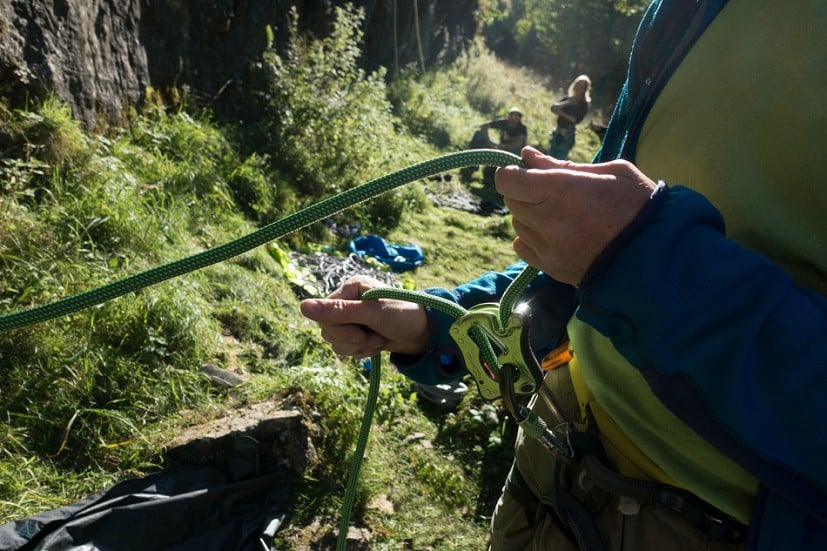

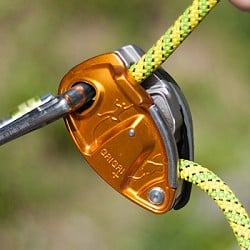
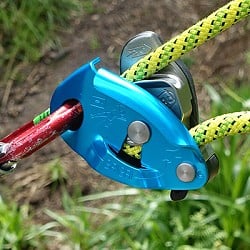
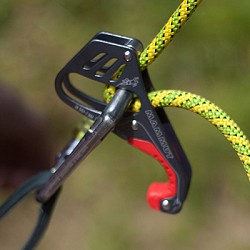




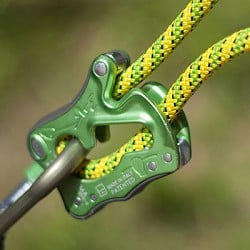
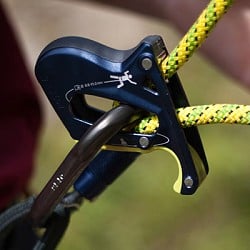
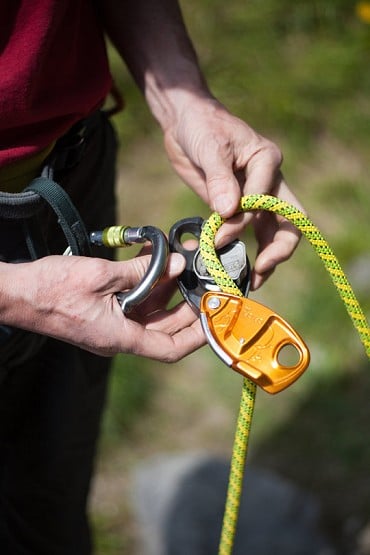
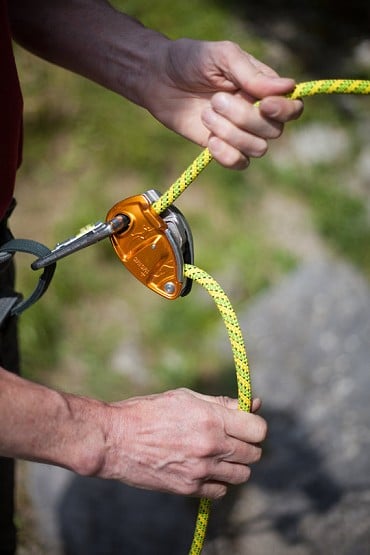
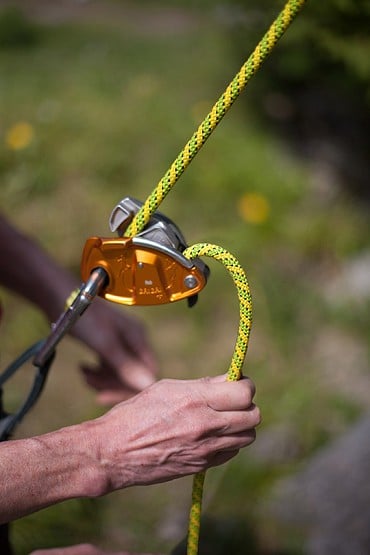
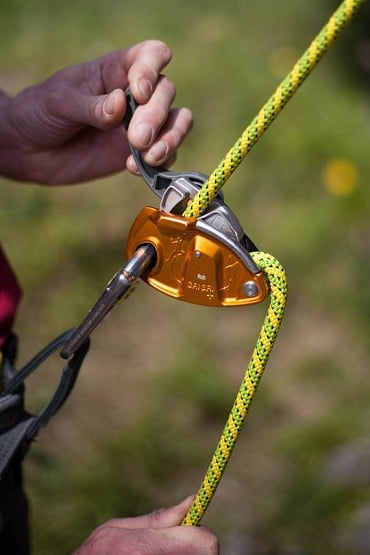
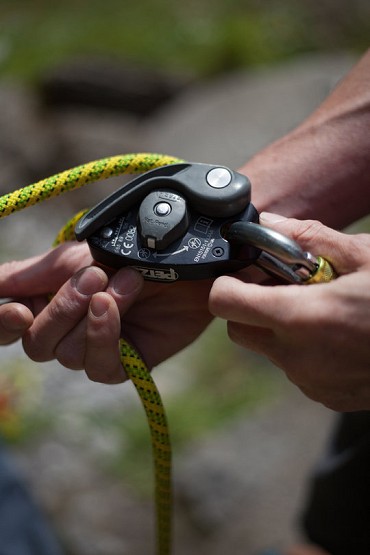
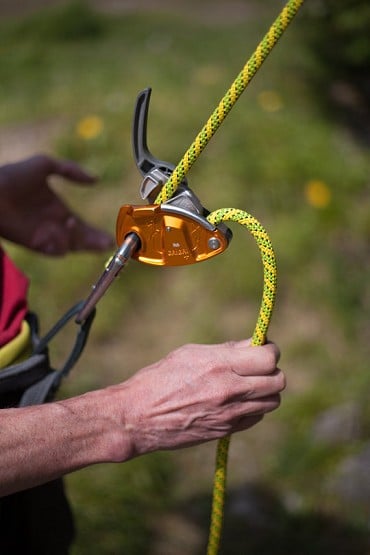
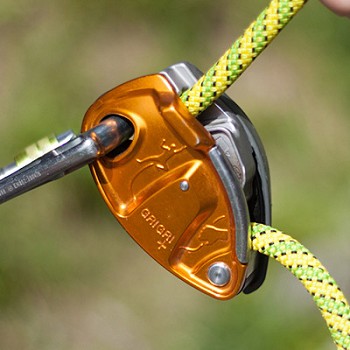
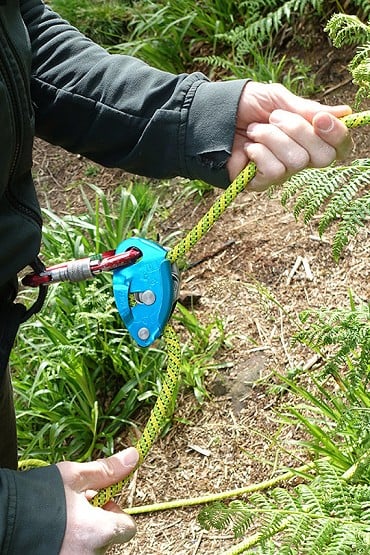
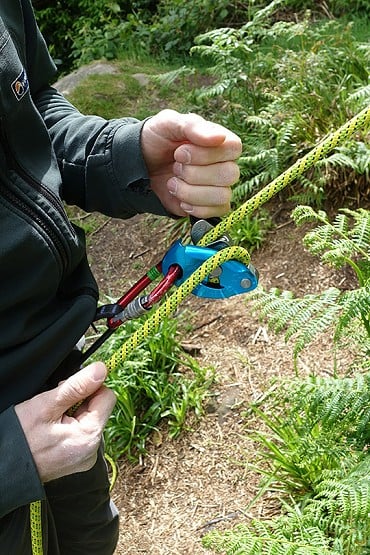
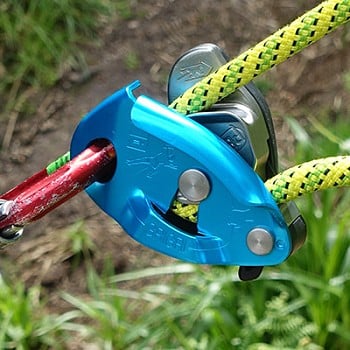
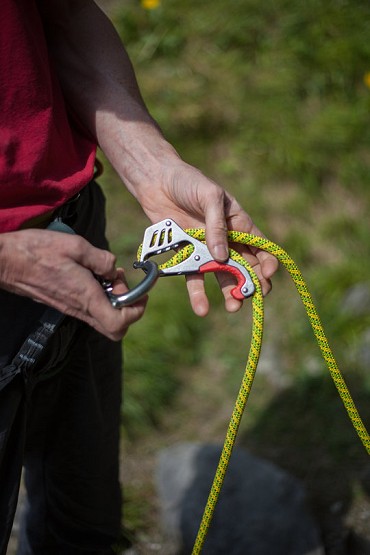
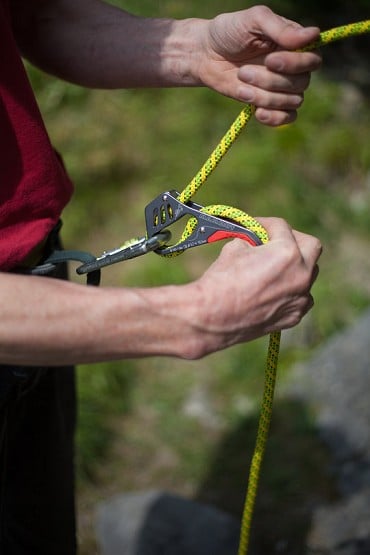
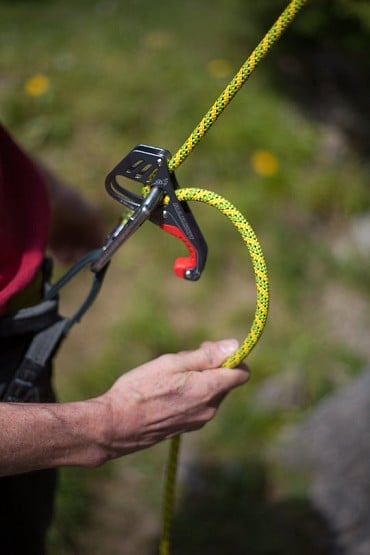
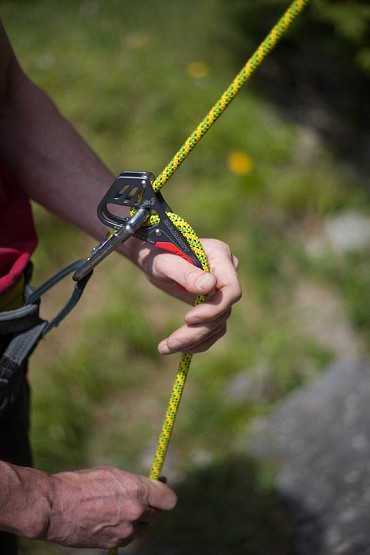
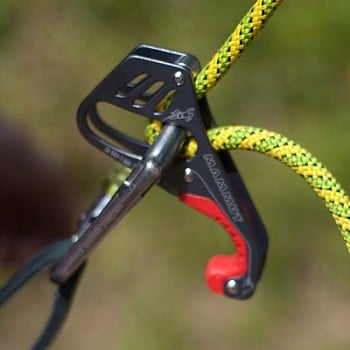

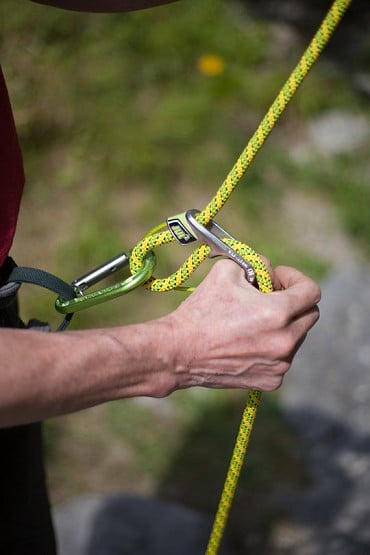
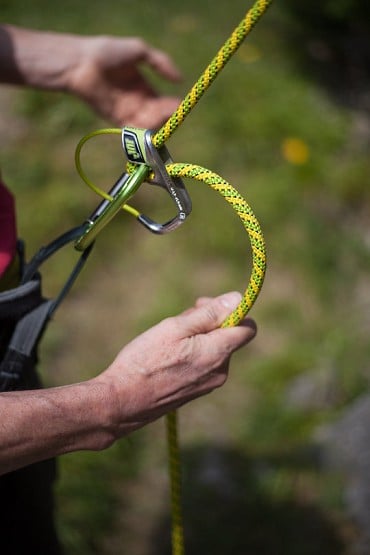
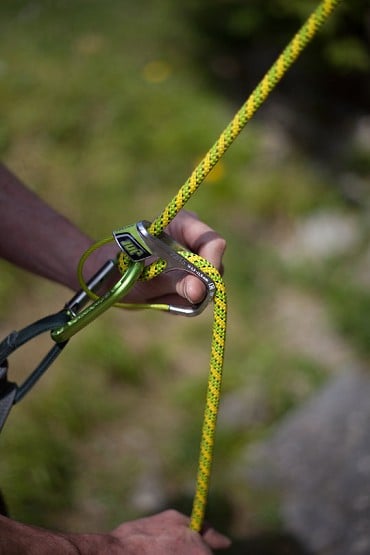
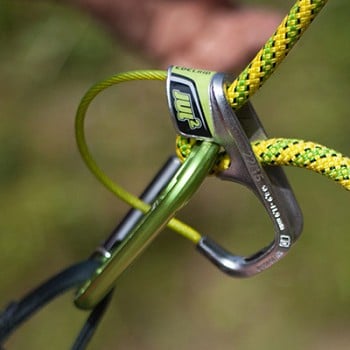
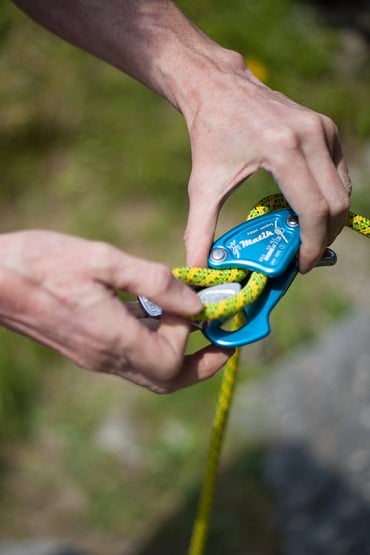
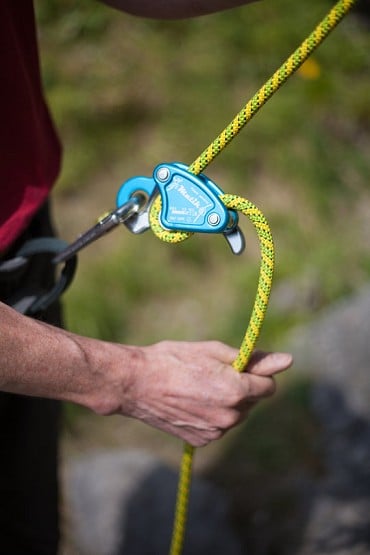
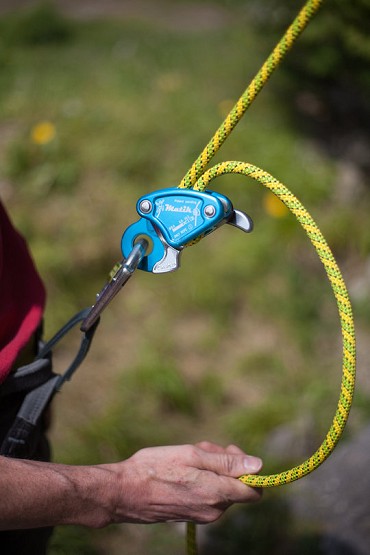
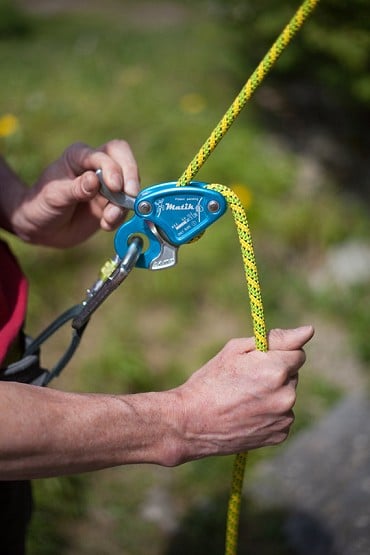

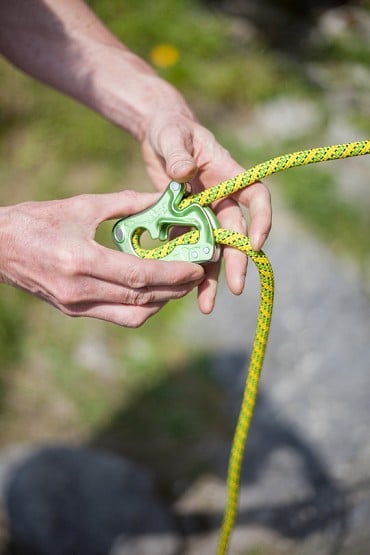
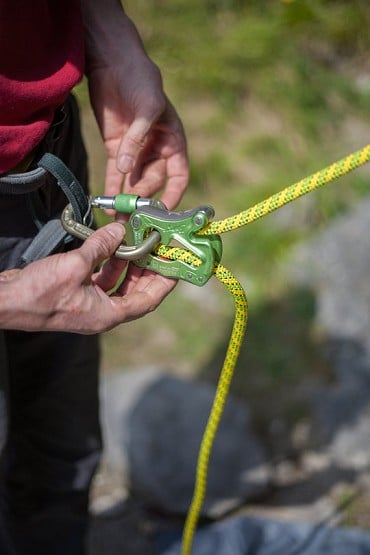
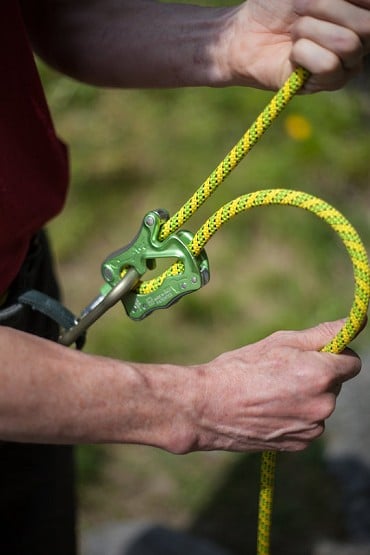


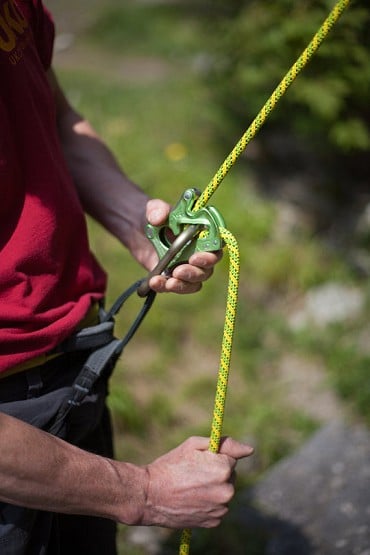

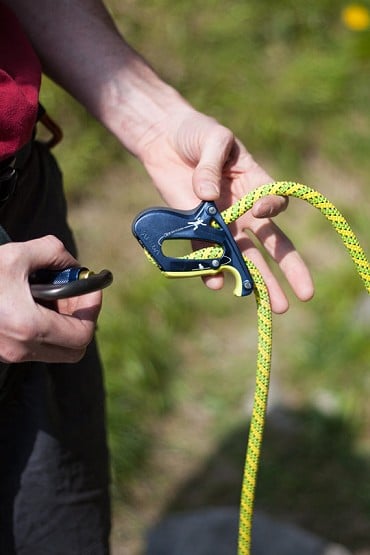
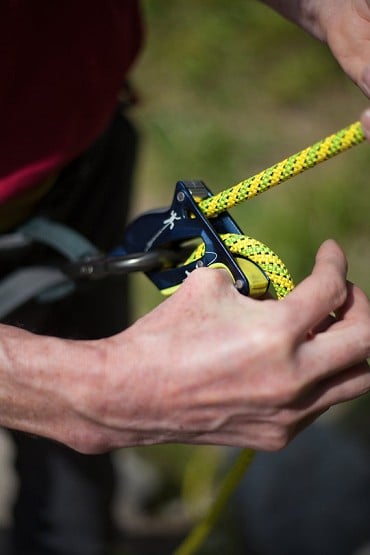
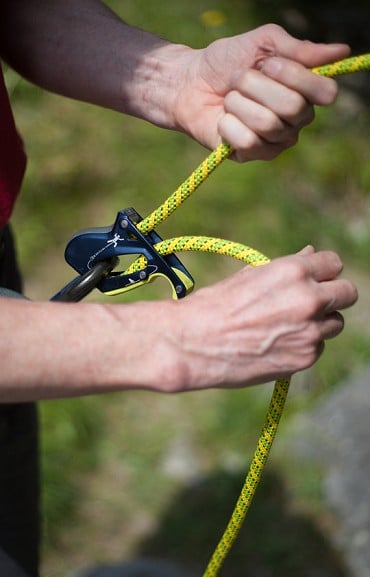
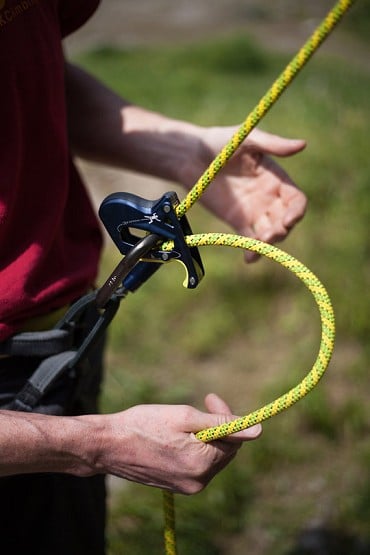
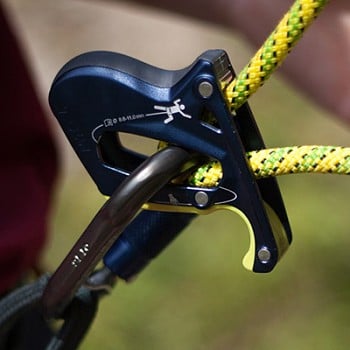

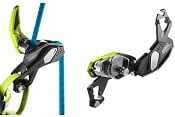
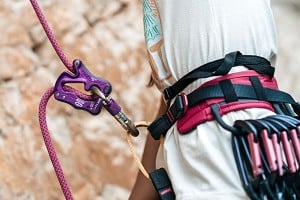
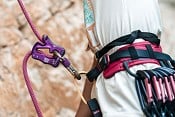
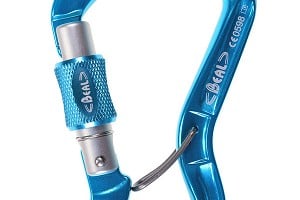
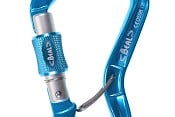
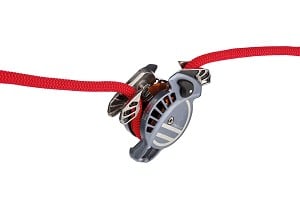
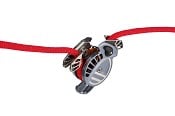
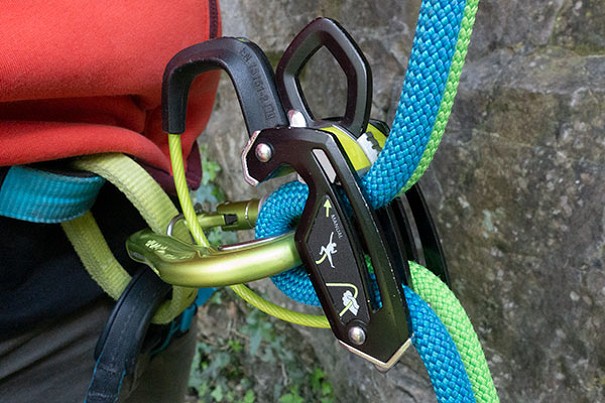
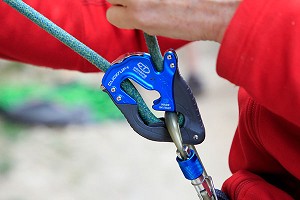
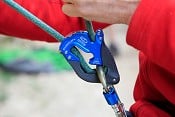
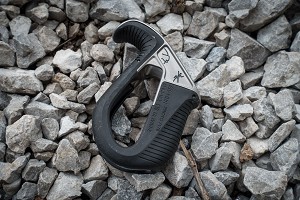
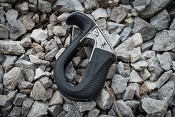
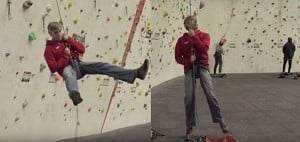

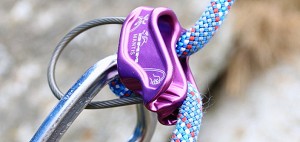

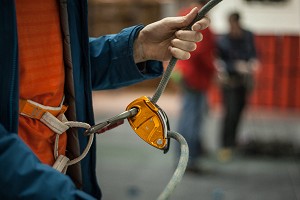
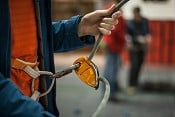
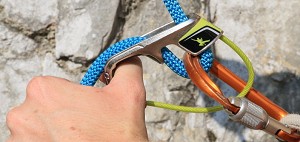

Comments